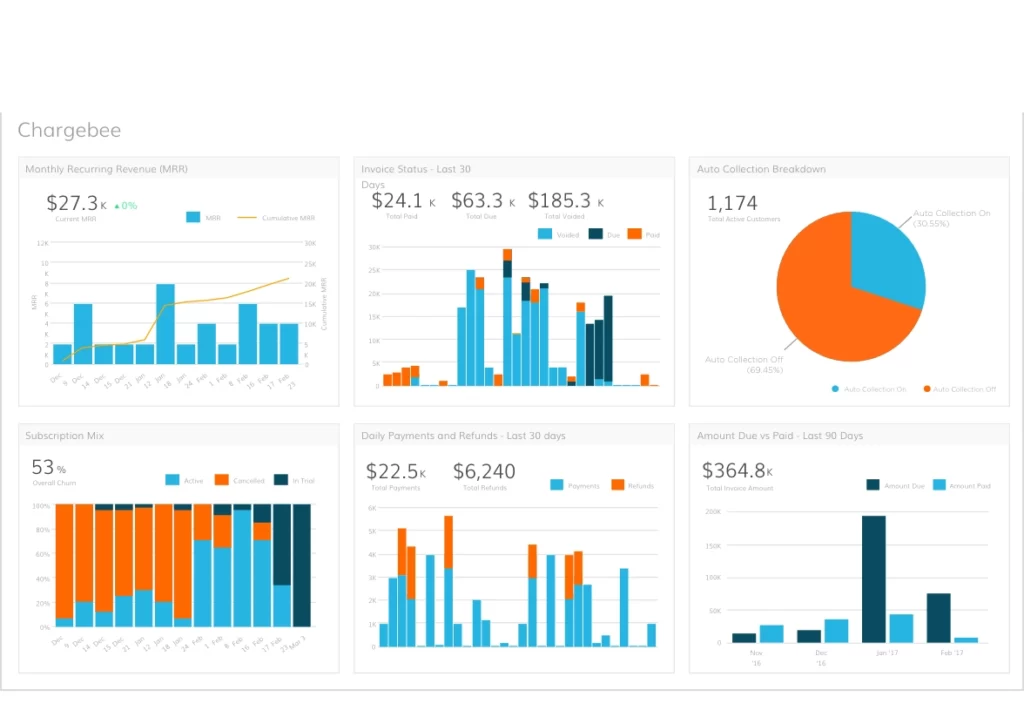SaaS accounting refers to the specific accounting practices used by Software as a Service (SaaS) companies. Since SaaS runs via subscriptions and recurring revenues, the accounting differs from standard accounting designed for sales and purchases.
This guide covers everything SaaS businesses need for revenue recognition, financial reporting, metrics, accounting software, and strategies to leverage accounting data for growth in 2024.
Key Takeaways
- SaaS accounting uses accrual accounting to recognize revenue and expenses based on usage rather than just cash transactions. This matches revenue with expenses.
- SaaS revenue recognition follows accounting standards like ASC 606 and IFRS 15 to determine when to record recurring subscription revenue.
- Key SaaS accounting metrics include ARR, MRR, churn rate, CAC, LTV, gross margin, net revenue retention, and more.
- Choosing the right accounting software and methods is essential for accurate financial reporting.
- As a subscription business model, SaaS accounting requires tracking recurring future revenue and deferred revenue.
Why Accurate Accounting Matters for SaaS Companies
Every SaaS company relies on an accounting system to record revenue and expenses. This provides essential financial reporting for investors, banks, shareholders, and paying tax agencies.
Robust accounting is the best way for SaaS businesses to:
- Recognize revenues accurately: Match revenue earned to the appropriate period instead of just when cash is received.
- Coordinate expenses with revenue: Match expenses like salaries or infrastructure costs to when revenue is earned.
- Plan using financial metrics: Use key SaaS metrics around revenues, margins, churn, LTV, CAC, etc.
- Raise funding: Provide financial statements to solicit investors and loans.
- Manage cash flow: Understand future incoming cash from subscriptions and when more considerable expenses need payment.
In short, without consistent accounting, SaaS companies operate in the dark financially. The stakes become even more significant as the company grows.

SaaS Accounting Challenges and Methods
SaaS accounting has inherent challenges since it differs significantly from product-based business models with simple one-time sales.
Some key ways SaaS accounting stands apart include:
Revenue over time: Unlike single sales, subscription revenue trails over months or years. Accounts need tracking as subscriptions are renewed, upgraded/downgraded, or discontinued.
Deferred revenue: Sometimes, revenue is collected upfront for future access; hence, it is considered “deferred revenue” until earned. This is generally called “contract liability”.
Usage variability: Customers may use (and be billed for) higher or lower access levels at any time. Tracking usage volume is, therefore, paramount.
No overstock: Since SaaS delivers software similarly for all users, there is little concept of unsold inventory or returns.
Service costs: Hosting a SaaS solution requires consistent infrastructure, bandwidth, engineering, support, and operating expenses unrelated to direct sales.
SaaS businesses universally use accrual accounting instead of cash accounting to address these dynamics.
Under accrual methods, revenue and expenses get recorded when transactions occur, not necessarily when cash changes hands. This enables matching revenues to appropriate periods when they are earned.
Let’s explore accrual accounting next…
Accrual Accounting for SaaS Businesses
Most SaaS companies use accrual-based accounting as mandated by accounting standards boards. This method accurately matches earned revenue to related expenses by recording when they occur, irrespective of cash.
For example:
- Revenue gets counted when subscriptions provide customer access, not when cash is collected. This applies both to new customers and subscription renewals.
- Expenses like servers, payroll, etc., are recorded when they helped earn revenue, whether before or after cash payments.
The alternative method, cash accounting, only records Revenues and Expenses when cash transactions happen. This fails to provide accurate financial statements, so it is typically only used by self-proprietorships or partnerships without outside investors/lenders.
Some fundamental tenets of accrual accounting relevant to SaaS include:
Deferred Revenue: “Contract liability” refers to payments received upfront before delivering service, hence not yet “earned.” It appears as a liability until earned over the subscription period.
Unbilled Revenue: Unlike deferred revenue, this is revenue already earned, but no cash has been received yet per agreements. This appears as an accrued asset until the actual cash receipt.
Revenue Recognition: Guidelines per GAAP or IFRS on when recurring subscription revenue should get counted over long-term contracts instead of upfront.
Matching Principle: Expenses related to delivering service are recorded in the same reporting period as the earned revenue, which may differ from the timing of cash flows.
Now let’s examine revenue recognition, which is essential for all SaaS accounting…

SaaS Revenue Recognition Standards
Recording and reporting revenue is one of the trickiest issues in accounting. Rules exist on when revenues can be formally counted on financial statements during longer-term agreements.
For SaaS companies, the highly detailed ASC 606 and IFRS 15 standards guide revenue recognition across industries, including software/cloud subscriptions.
Some critical requirements before SaaS companies can recognize revenue:
- Identify the customer contract: The start timing, renewal triggers, pricing terms, etc., need clarity, even for unsigned agreements.
- Define performance obligations: The subscription access or software service level owed to the customer.
- Calculate transaction cost: Any discounts, returns, refunds, etc., that impact revenue numbers.
- Allocate revenue: Split and defer revenue for multi-year contracts to attribute it reasonably over subscription periods.
- Assess collectability: Evaluate if cash receipt disputes make revenue recognition risky.
Additional rules apply for free trials, refunds, discounts, upgrades/downgrades, and contract modifications to handle deferred revenue properly.
In essence, SaaS firms can only count revenue after providing ongoing access per agreement in proportion to the duration of the service period.
Let’s break this down further…
Each periodic subscription payment would broadly be recognized as revenue for monthly customers when the next billing cycle starts.
For annual contracts, the yearly payment needs to be divided over each month for revenue-counting purposes rather than taking it all initially.
Recognizing the bulk upfront fails to match the ongoing service delivery and distorts financial results until renewal a year later. It also inflates taxable income incorrectly in the first period.
Accrual accounting enables accurate reporting on SaaS financial performance by allocating revenue across subscription durations. Now let’s explore why tracking key SaaS metrics is so valuable…
Top SaaS Accounting Metrics and Benchmarks
Beyond income/expense reporting, accounting data unlocks valuable SaaS metrics to operate better as a subscription business.
Let’s explore some famous SaaS metrics to track:
MRR or Monthly Recurring Revenue – Total monthly value of active subscriptions
ARR or Annual Recurring Revenue – Total annual value of active subscriptions
CAC or Customer Acquisition Cost – Full costs to land new accounts
LTV or Lifetime Value – Predicted revenue from a customer before churn
Net Revenue Retention – Renewal revenues from ongoing clients
Gross Margin – Revenue remaining after direct subscription costs
Churn Rate – Percentage of subscriptions discontinued monthly
Monitoring changes in these over time indicates business health and demonstrates progress to investors.
Industry SaaS benchmarks exist to help gauge standard ranges expected for metrics. While varying some based on business model, here are some examples:

- Gross Margin: 60-80%+
- Net Revenue Retention: 100-120%+
- MRR Churn: 5-7% monthly
- CAC Payback Time: 6-12 months
- ARR Growth Rate – 20-100% yearly
See how your SaaS business measures up over the next year by closely tracking operations through accrual accounting.
Now, let’s discuss critical software considerations for managing SaaS finances…
Choosing Accounting Software for SaaS
Using a modern software platform tailored to handle recurring revenue recognition, deferred revenue, and key metrics can make financial management much more accessible for SaaS providers.
Here are valuable features to have:
- Recurring billing and revenue tracking – Automates daily recognition from subscriptions.
- Handling prepaid & unpaid revenue – Tracks all contract liability and unbilled accrued income.
- Revenue allocation – Enables splitting income to appropriate periods.
- Performance metrics – Provides dashboard tracking of KPIs like MRR, LTV, etc.
- Financial reports – Income statements, cash flow projections, and accrual statements.
- Taxes – Supports tax estimates and filings across regions.
- Integrations – Connects with payment gateways, banks, payroll, etc.
- Customization – Models complicated agreements and reporting needs.
Top software picks combining robust accounting with subscription management include:
- NetSuite
- Sage Intacct
- Chargebee
- Recurly
- ProfitWell
- ChartMogul
- Napier
- Putler
Leverage suitable accounting systems to focus on customers and products while easily monitoring the SaaS business performance.

Now, let’s explore intelligent financial strategies to scale growth in 2024.
SaaS Accounting Strategies for Revenue Growth
With sound revenue recognition policies and metrics-driven systems, SaaS businesses can leverage accounting data for strategic decisions to drive expansion.
1. Boost net revenue retention from current customers – Watch for churn indicators and long-term value changes to redouble client success efforts for the most at-risk accounts. Upselling additional tiers over time also improves retention revenues.
2. Tighten customer acquisition costs through testing – Compare the revenues delivered from various marketing channels and sales operations against their true fully-loaded costs to optimize how you deploy future lead generation budget based on yield.
3. Model subscription plans against long-term margins – Forecast expected service delivery costs supporting customers across possible pricing tiers to find and promote levels that balance growth with healthy profit margins.
4. Project personnel needs ahead of growth – Hiring too slowly creates service backlogs that churn customers. Hiring too fast raises costs low revenues can’t support yet. Model forward subscription volumes, revenues and margins to size teams appropriately.
5. Plan infrastructure expansion required – Hardware, network and tools should scale to foreseeable peaks in subscribers so you can retain rather than churn them. Cost accounting helps see true supporting overhead to handle more users per tier.
In summary, leaning into sound accrual accounting and metrics gives SaaS businesses unique advantages to outperform competitors. Master these best practices and reporting approaches to make smart moves that compound customer growth and revenues in 2024.

Frequently Asked Questions
Here are answers to some common questions SaaS companies have about accounting best practices:
- Why use accrual and not cash accounting? Accrual better matches earned revenue to period costs so is mandated under GAAP and IFRS. It provides much more accurate financial performance tracking.
- When is deferred revenue counted on the books? Prepaid amounts get held as a liability until earned by delivering software access over the subscription period per revenue recognition rules.
- How often do accrual statements get adjusted? Income and expense accruals should be reconciled and adjusted at least monthly to reflect the latest subscription volumes and metric impacts.
- Can revenue get recognized before providing service? No, revenue recognition standards prohibit recording earned revenue before software access starts per the subscription agreements.
- How are one-time overages handled?
Spikes in usage above standard tiers often get billed arrears so accrue as unbilled revenue until the end customer gets invoiced. - What financials get provided to external investors? Income statements, Statements of Owner’s Equity, Balance Sheets and Cash Flow Statements should present using accrual accounting under GAAP or IFRS depending on jurisdictions.
- How does accounting differ for enterprise SaaS? Larger deals may require inventory tracking for add-on services plus revenue allocation across various performance obligations and customer sites.
- Why track metrics like CAC and LTV? Customer acquisition costs and lifetime values help greatly in modeling profitable growth rates and required targets by acquisition channel.
- How are sales taxes and VAT handled? Usage, product catalog, address and tax nexus data feeds calculation of taxes due across jurisdictions, with automation to file and remit payments.
- Which employees help with SaaS accounting? While software can assist greatly, skilled controllers, analysts and accountants focusing on recurring revenue streams best enable timely and compliant financial reporting.
If you still need help with implementing the accounting strategies outlined here at your SaaS company, don’t hesitate to reach out to specialized advisory firms for additional expertise tailored to your situation.




Leave a Reply